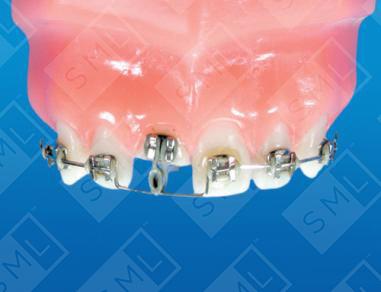When using a fixed approach, the equivalent of two teeth on either side of the tooth to be erupted must be available for anchorage. The appliance is set up as follows: The Anchorage Unit: Edgewise brackets are bonded into place in the same horizontal plane on all of the anchor teeth. The teeth on each side of the tooth to be erupted are then tied together with metal ligature ties to create the two anchor units. This will eliminate any unwanted movement of these anchor units. A stainless steel orthodontic wire, 0.018 inch by 0.025 inch, is then ligated into the brackets of the anchorage units with elastic ligatures. This wire has been bent by the lab to the general labial contours of the anchorage teeth and the crown of the tooth to be extruded. An occlusal offset has been placed in the wire over the tooth to be extruded. This wire, when properly positioned inciso-gingivally, will provide the needed extrusion distance between the wire and the attachment on the tooth needing eruption. The Attachment Unit: The attachment unit is the part of the appliance that attaches to the tooth needing eruption. The preferred method is bonding a bracket to natural tooth enamel. However, if there is no labial enamel to bond to then the next best options are a temporary, or a final post and core, and a temporary crown. A temporary crown has the advantage of being more esthetically pleasing while retaining the tooth’s original position. After the temporary crown has been constructed, an orthodontic bracket is bonded to its surface as far to the gingival as possible. The Active Force Module: After placing the arch wire, you can activate the appliance. An elastic is placed from the attachment, looped over the wire and back on to the attachment, to initiate the eruption. In this example, chain elastic is being used.



